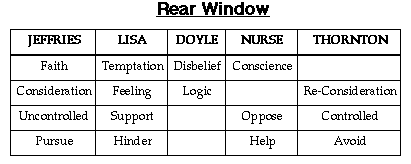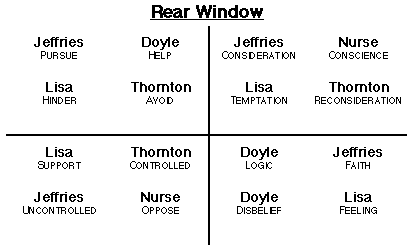Principal Characters in Rear Window
If there is anything that can be seen as “typical” about a Hitchcock film it would be his forefront use of thematics. Rear Window is no exception. As with Gone With the Wind, the enjoyment of the story comes largely from what happens between the lines. But unlike GWTW, the characters in Rear Window are relatively complex.
At first glance, it may seem that there are quite a few characters, what with the neighbors and all. There’s the Composer, trying to sell his first hit song. There’s Miss Lonely Heart, who can’t get a date. We see a lot of Miss Torso who exercises in front of her open window. Upstairs is the Couple With the Dog, downstairs, the Sunbather. And, of course, Thornton the murderer.
More prominent, of course, is Jeffries and the characters we see in his apartment: his girlfriend Lisa; Doyle, the detective; and his Nurse. (It is important to note that Thornton also shows up in Jeffries’ apartment near the end of the story and is the only neighbor to do so.)
The Top Five
The purpose of characters is to show how aspects of the Story Mind deal with a problem. And this is what determines that the neighbors are not Objective Characters. Aside from Thornton, they all have their own little stories, but only interact with each other peripherally, if at all. Their private stories enhance the thematic atmosphere of the overall story but neither advance nor clarify the plot.If we eliminate all the neighbors who do not interact, we pare our list down to five actual characters: Jeffries, Lisa, Doyle, Nurse, and Thornton. If Rear Window is well written, we would expect all sixteen motivation Elements to be distributed among these five. Let’s see if they are.
Elements of the Top Five
Who represents FAITH? Unquestionably Jeffries. He maintains his belief that a murder has been committed in the face of objections by each of the other characters. Lisa can’t talk him out of it and neither can his Nurse. Thornton denies it by his actions and Doyle is not convinced until after the proof is irrefutable. In fact, Doyle personifies DISBELIEF, even while HELPING Jeffries gain information to which he would not otherwise have access. Lisa comes around to accepting the possibility and so does Nurse. Thornton already knows the truth, but Doyle is never convinced until he sees the proof with his own eyes.In addition, Doyle relies on LOGIC to support his disbelief. He will not accept Jeffries’ contentions without logical arguments. Then is Jeffries FEELING? No. Jeffries does not disregard Logic in his considerations; he merely can’t supply it. Jeffries urges the others to CONSIDER what he knows and what he suspects. Lisa, on the other hand, continually acts on impulse without regard for logic, illustrating nicely the characteristic of FEELING.
If Jeffries is CONSIDERATION, we would expect his nemesis, Thornton, to cause RECONSIDERATION, and he does. Thornton’s apparently guilt-free actions are a constant force that urges Jeffries (and the others) to RECONSIDER. All we ever see of him is that he acts methodically to carry out his plan, whatever that might be. It is his methodical approach that makes Thornton the CONTROL Character as well. He wastes no time or energy on anything but the task at hand, whereas Jeffries dabbles at whatever fills his view, even when it interferes with his goal of getting the goods on Thornton. Jeffries plainly illustrates the Element of being UNCONTROLLED.
Even though Lisa SUPPORTS Jeffries in his quest, she manages to HINDER his efforts through distraction and re-direction of their conversations. She clearly TEMPTS him to give up PURSUING this crazy scheme. In contrast, Jeffries’ Nurse OPPOSES his efforts, even while providing a moralistic philosophy or CONSCIENCE to his every comment. And, of course, Thornton would prefer to AVOID the whole thing.
Characteristic Lists
If we take a slightly different form, we can arrange the five Characters as column headings and list their characteristics beneath them.
Rear Window Characters in the Motivation Set
Assigning the Character names of Rear Window to the Motivation Characteristic Quads we get:
Using the grid above we can predict the principal conflicts of Rear Window simply by noting which characters are in Dynamic (diagonal) positions and the issues (Elements) over which each pair will diverge.
In summary, the set of sixteen Motivation Elements offers a valuable tool for understanding some of the essential building blocks of Objective Characters and how they can be distributed to create both Archetypal and Complex characters.







No comments:
Post a Comment